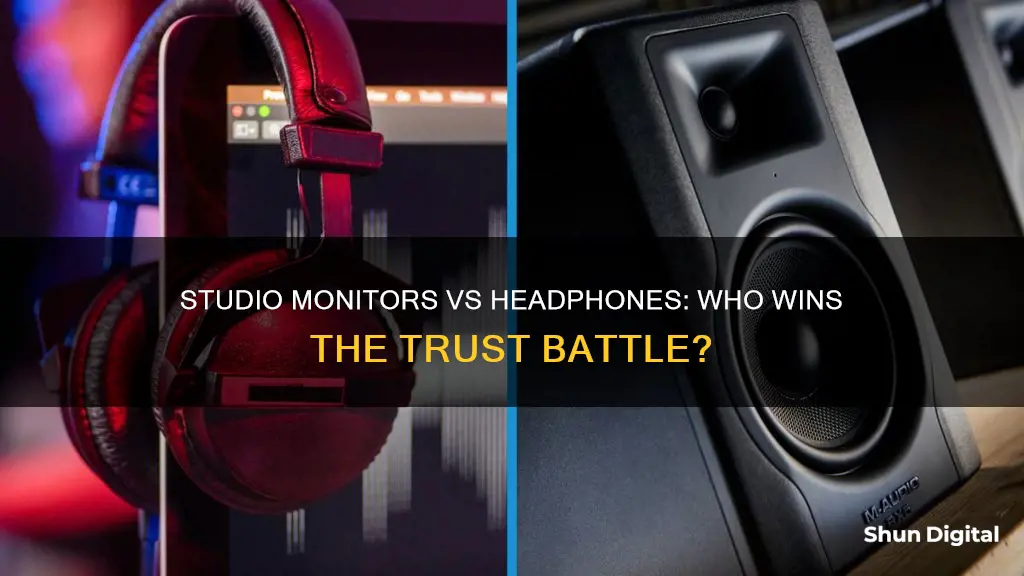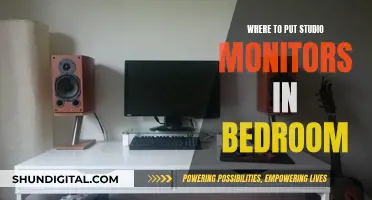
Studio monitors and headphones each have their pros and cons, and the best monitoring solution depends on the user's circumstances. Studio monitors provide the most authentic and natural-sounding representation of tracks, while headphones can be more practical and provide a reliable alternative solution by cutting out distracting room reflections and ambient noise.
| Characteristics | Values |
|---|---|
| Sound | Studio monitors provide a more natural and authentic sound, whereas headphones can cause an overemphasis of certain frequencies. |
| Environment | Studio monitors are better suited for acoustically treated rooms, while headphones are a more reliable option for untreated rooms. |
| Volume | Studio monitors require louder volumes for a balanced representation of all frequencies, which may be an issue for those with thin walls or close neighbours. |
| Detail | Headphones are better for spotting details such as unwanted distortion and clipping, as they cut out distracting room reflections and ambient noise. |
| Convenience | Headphones can be used anytime without disturbing others, while studio monitors may be limited by time of day and proximity to neighbours. |
| Panning | Studio monitors provide a more accurate representation of panning, as the sound source is external. Headphones can make it difficult to judge panning choices accurately. |
| Practicality | Studio monitors may not be a practical option for those without a dedicated mix room or studio space. Headphones offer a more flexible and portable solution. |
What You'll Learn

Studio monitors are more authentic and natural-sounding
Studio monitors physically push sound waves around the room. These waves are reflected and absorbed by objects in the room, and the ensuing shifts in timing and phase provide our brain with volume and directional information that feels natural and organic.
The human auditory system perceives sound differently when listening on headphones. Both ears are fed their own channels at precisely the same time, resulting in a sound that seems to be coming from inside the middle of the head, rather than in front. This results in a perception of the stereo image that is very different from that of monitors.
Panned instruments may seem more widely spaced, and effects like reverb and delay may appear deeper and wider. Plus, with headphones, you don't get the influence of room acoustics on the overall sound that you do with monitors.
Hooking Up Multiple Monitors to Your GeForce Graphics Card
You may want to see also

Headphones are more practical for those without a dedicated studio space
For those without a dedicated studio space, headphones are a more practical option. This is especially true for those living in shared accommodation or with sensitive neighbours, as studio monitors can be loud and cause disruption.
Headphones are also a more affordable option, as studio monitors require a significant financial outlay, not only for the speakers themselves but also for room treatment and acoustic correction software. Headphones can be used anywhere, at any time, and do not require a specialised space. They are also a more portable option, which is beneficial for those who travel or work in different locations.
Additionally, headphones can provide a more detailed listening experience, allowing the user to focus on specific elements of the mix, such as unwanted distortion, clipping, and clicks. They can also be used to compare mixes with reference tracks, ensuring that the balance and levels are consistent.
However, it is important to be aware of the limitations of headphones. The stereo image may appear narrower when played back on speakers, and panning, reverb, and delay effects may need to be adjusted accordingly. It is also crucial to choose headphones with a flat frequency response to ensure an accurate representation of the mix.
In conclusion, while both options have their advantages and disadvantages, headphones are a more practical choice for those without a dedicated studio space due to their affordability, portability, and ability to provide a detailed listening experience.
Troubleshooting Black-Screen Issues on LCD Monitors
You may want to see also

Headphones can be used to hear details that may be missed with monitors
Headphones can be a great way to hear details in your music that may be missed with studio monitors.
Firstly, headphones can provide a more detailed and accurate listening experience. They are designed to reproduce sound that is as close to the original recording as possible. This means that you can hear the music as the musicians and producers intended, with all the intricacies of each instrument. This level of detail can be missed when using studio monitors, as the sound is affected by the acoustics of the room.
Additionally, headphones can help you identify and focus on specific details in your music, such as unwanted distortion, clipping, and clicks. With headphones, you can more easily spot tonal clashes between instruments in the same frequency range, wayward vocal timings, or pitching issues. This is because headphones deliver sound directly into your ears, without the influence of room acoustics or reflections that can alter the characteristics of the music.
The design of headphones also contributes to their ability to deliver a detailed listening experience. Headphones have a wide and flat frequency response, allowing them to reproduce a broader range of frequencies than standard models. This includes frequencies within and sometimes beyond the standard human hearing range of 20-20,000 Hz. A flat frequency response means that all frequencies remain level across the entire range, resulting in a neutral sound that is not coloured or altered. This is in contrast to consumer-grade headphones that often have a boosted bass or elevated treble response, which can make the music sound more fun but can also mask details in the track.
Furthermore, headphones are often more comfortable to wear for extended periods, which is important for producers and musicians who spend long hours in the studio. The comfort factor, combined with their ability to block out ambient noise, makes headphones ideal for detailed music listening and analysis.
Lastly, headphones are a practical choice for detailed music listening as they can be used anywhere, at any time, without disturbing others. Studio monitors, on the other hand, require a dedicated space and can be too loud for neighbours or others in close proximity.
In conclusion, while both studio monitors and headphones have their advantages, headphones excel at providing a detailed and accurate listening experience. They offer a more intimate and isolated way to focus on the intricacies of your music, making them a valuable tool for producers, musicians, and anyone who wants to hear all the nuances of their favourite tracks.
Verizon's Hotspot Usage Monitoring: What You Need to Know
You may want to see also

Monitors require a 'break-in' period
Studio monitors require a break-in period. This is because there are mechanical elements within the drivers that need to settle and adapt to the climate of your mixing space. The break-in period is not a cause for concern, but rather a minor adjustment that allows your cones to ease into their function.
To break in your studio monitors, play music through them at moderate levels for around twenty hours. Choose songs with significant low-frequency content. Once the transducers stabilize, you will be able to enjoy optimum performance and a playback experience as the manufacturer intended.
It is worth noting that this process is not just specific to studio monitors, but also applies to other electronic equipment such as LCD screens. In the case of LCD screens, a break-in period of 24+ hours is recommended to allow for the necessary settling of pixels, backlights, and optic layers.
While some people swear by the importance of breaking in studio monitors, others consider it a myth. Ultimately, the decision to break in your studio monitors is up to you. However, it is always a good idea to follow the manufacturer's instructions and recommendations for the best results.
Finding Faulty Silverado TPS Monitors: A Step-by-Step Guide
You may want to see also

Monitors are better for panning
Studio monitors and headphones each have their own advantages and disadvantages when it comes to mixing audio. While headphones can be a more convenient option, especially when dealing with noisy neighbours or untreated rooms, studio monitors offer a more natural and authentic representation of your tracks.
When it comes to panning, studio monitors are the better option. Panning refers to the distribution of sound across the stereo field, and it plays a crucial role in creating a sense of space and depth in a mix. With studio monitors, the sound is projected into the room, allowing for a more natural and accurate perception of the stereo image. This is because, in the real world, sound arrives at your ears from various angles and distances, creating a sense of depth and space.
On the other hand, headphones deliver sound directly into your ears, resulting in a perception of sound that seems to be coming from inside your head. This can make it challenging to accurately judge the placement of sounds in the stereo field. With headphones, it's easy to fall into the trap of thinking that a moderate pan will be enough to shift a sound from the centre, when in reality, a harder pan may be necessary. This can lead to mixes that sound unbalanced when played back on speakers, with certain elements appearing too far to one side.
Additionally, the crosstalk effect, which occurs when sound from one speaker reaches both ears, is absent when using headphones. In a normal listening environment, each ear hears a bit of the opposite speaker's information. This crosstalk helps us to localise sounds and perceive the stereo image accurately. When mixing with headphones, this effect is lost, making it more difficult to make informed panning decisions.
While software tools exist to help emulate the monitor mixing experience on headphones, they are not always necessary. By understanding the differences between headphones and studio monitors, you can make adjustments to your mixes to compensate for the unique characteristics of each listening environment. For example, when mixing on headphones, you may need to widen your pans or increase the wet levels of your plugins to achieve the desired effect when played back on speakers.
In conclusion, while both headphones and studio monitors have their place in the mixing process, studio monitors are generally better for panning due to their ability to provide a more natural and accurate representation of the stereo image. By mixing on studio monitors, you can more easily create a sense of space and depth in your mixes, ensuring that your audio translates well across different listening environments.
Repairing Your ASUS LCD Monitor Buttons: A Step-by-Step Guide
You may want to see also
Frequently asked questions
You can achieve quality mixes on either, or in tandem. Ideally, you use both to analyse different aspects of your mix so you can produce audio that translates well across different listening environments.
Studio monitors provide the most authentic and natural-sounding representation of your tracks. Monitor speakers have cones that physically push sound waves around the room and the ensuing shifts in timing and phase provide our brain with volume and directional information that feels natural and organic.
Headphones are great for spotting and homing in on details such as unwanted distortion, clipping and clicks. They can also be used day or night, at a reasonable volume, without bothering the neighbours.







